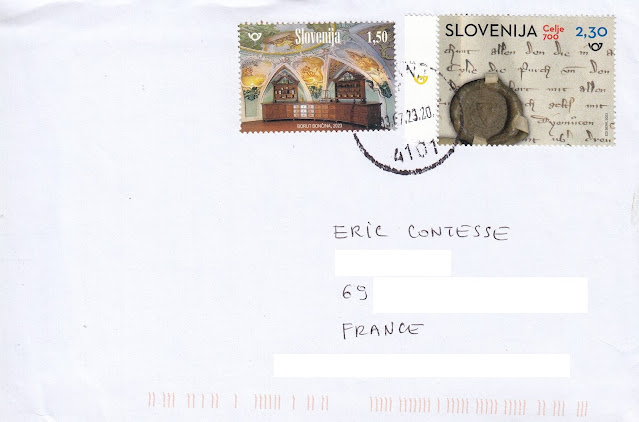700 ans de la ville de Celje et plus ancienne pharmacie sur lettre de Slovénie
Merci Petra pour cette intéressante lettre envoyée le 3 juillet 2023 depuis la ville de Kranj, incluant 2 timbres émis le 31 mars 2023, consacrés respectivement au 700ème anniversaire de la ville de Celje et à la plus ancienne pharmacie de Slovénie.
Le timbre à gauche (1,50€, tirage : 30000), conçu par Borut Bončina, fait partie d'une nouvelle série consacrée au tourisme et en particulier à des exemples les plus extraordinaires du paysage naturel et culturel de la Slovénie.
Ce timbre illustre la plus ancienne pharmacie de Slovénie, qui se trouve également être la 3ème plus ancienne en Europe (seuls Paris et Dubrovnik en possédent une plus ancienne). Cette pharmacie est située au rez-de-chaussée de la tour gauche de l'ancien château d'Olimje (centre-est du pays) qui est devenu en 1663 un monastère des Pères Paulins. Outre leur travail pastoral et leurs activités de bâtisseurs, les moines s'occupent de pharmacologie et, en particulier, d'herboristerie.
Le mobilier et l'équipement de la pharmacie n'ont pas survécu, à
l'exception des fresques peintes en 1780 par Anton Lerchinger de Rogatec
(représentées sur le timbre). Il s'agit de scènes bibliques et de
représentations de médecins célèbres, d'Esculape à Paracelse.
Thank you Petra for this interesting cover sent on July 3, 2023 from the city of Kranj, including two stamps issued on March 31, 2023, dedicated respectively to the 700th anniversary of the city of Celje and to the oldest pharmacy in Slovenia.
The stamp on the left (€1.50, print run: 30,000), designed by Borut Bončina, is part of a new series dedicated to tourism and in particular to the most extraordinary examples of Slovenia's natural and cultural landscape.
This stamp illustrates the oldest pharmacy in Slovenia, which also happens to be the 3rd oldest in Europe (only Paris and Dubrovnik have an older one). This pharmacy is located on the ground floor of the left tower of the old castle of Olimje (center-east of the country) which in 1663 became a monastery of the Pauline Fathers. In addition to their pastoral work and their activities as builders, the monks deal with pharmacology and, in particular, with herbalism.
The furniture and equipment of the pharmacy have not survived, except for the frescoes painted in 1780 by Anton Lerchinger of Rogatec (depicted on the stamp). These are biblical scenes and representations of famous physicians, from Aesculapius to Paracelsus.
Les Pères Paulins ont été expulsés d'Olimje par l'empereur Joseph II en 1782. Après la Seconde Guerre mondiale, le monastère est nationalisé et les locaux de l'ancienne pharmacie sont utilisés pour stocker les récoltes. Depuis 1990, le bâtiment abrite une communauté de frères mineurs, qui ont renoué avec la tradition herboriste.
L'autre timbre (2,30€, tirage : 30000), conçu par Edi Berk, est consacré à Celje - Cité des Princes - à l'occasion des 700 ans de la publication mentionnant la ville pour la première fois.
Aux 12ème et 13ème siècles, Celje appartenait à la noble famille Heunburg. Après leur disparition en 1322, un âpre conflit éclata entre les principaux prétendants à leur riche héritage. Celje a été divisé, la moitié allant à Frédéric, le seigneur de Sanneck, et l'autre moitié allant à Elizabeth, la veuve d'Herman, le dernier des Heunburg, et au comte Ulrich V de Pfannberg.
Le 30 janvier 1323, Ulrich et Elizabeth cèdent leur moitié des domaines de Celje à Conrad d'Auffenstein, gouverneur et maréchal de Carinthie, pour une période de trois ans en échange de 500 marks d'argent. Cet arrangement couvrait "le château de Celje et le bourg en dessous, et la tour qui se dresse dans la ville, les nobles qui y vivent et les hommes armés qui leur appartiennent...".
Ce document, reproduit en partie sur ce timbre (avec un sceau arborant les armoiries de la ville incluant 3 étoiles), comporte ainsi les premières mentions écrites du vieux château de Celje, de Celje en tant que bourg et de la tour aujourd'hui connue sous le nom de palais princier.
The Pauline Fathers were expelled from Olimje by Emperor Joseph II in 1782. After World War II, the monastery was nationalized and the premises of the former pharmacy were used to store crops. Since 1990, the building has housed a community of Friars Minor, who have reconnected with the herbalist tradition.
The other stamp (€2.30, print run: 30,000), designed by Edi Berk, is dedicated to Celje - City of Princes - on the occasion of the 700th anniversary of the publication mentioning the city for the first time.
In the 12th and 13th centuries, Celje belonged to the noble Heunburg family. After they died out in 1322, a bitter conflict broke out among the main pretenders to their rich legacy. Celje was divided, with half going to Frederick, the lord of Sanneck, and the other half going to Elizabeth, the widow of Herman, the last of the Heunburgs, and to Count Ulrich V of Pfannberg.
On 30 January 1323, Ulrich and Elizabeth ceded their half of the Celje estates to Conrad of Auffenstein, governor and marshal of Carinthia, for a period of three years in exchange for 500 silver marks. This arrangement covered "the castle of Celje and the market town below it, and the tower which stands in the town, the nobles who live there and the armed men who belong to them...".
This document, reproduced in part on this stamp (with a seal bearing the coat of arms of the city including 3 stars), thus includes the first written mentions of the old castle of Celje, of Celje as a town and of the tower today known as the Princely Palace.

Aucun commentaire:
Enregistrer un commentaire